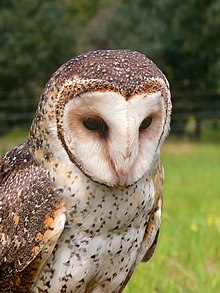
Back Nonnetjiesuile Afrikaans طيطونيات Arabic هامه (فصيله من الطيور) ARZ Tytonidae AST Murtoyek (Tytonidae) AVK Alabayquşlar Azerbaijani Сіпухавыя Byelorussian Забулени сови Bulgarian Tytonidae Breton Titònids Catalan
| Barn owls Temporal range: Late Eocene to present
| |
|---|---|

| |
| Australian masked owl (Tyto novaehollandiae) | |
| Scientific classification | |
| Domain: | Eukaryota |
| Kingdom: | Animalia |
| Phylum: | Chordata |
| Class: | Aves |
| Order: | Strigiformes |
| Family: | Tytonidae Ridgway, 1914 |
| Genera | |
| Synonyms | |
| |
Barn-owls (family Tytonidae) are one of the two families of owls, the other being the true owls or typical owls, Strigidae. They are medium to large owls with large heads and characteristic heart-shaped faces. They have long, strong legs with powerful talons. They also differ from the Strigidae in structural details relating in particular to the sternum and feet.[1]
Barn-owls are a wide-ranging family, although they are absent from northern North America, Saharan Africa, and large parts of Asia. They live in a wide range of habitats from deserts to forests, and from temperate latitudes to the tropics. Within these habitats, they live near agricultural areas with high amounts of human activity.[2] The majority of the 20 living species of barn-owls are poorly known. Some, like the red owl, have barely been seen or studied since their discovery, in contrast to the common barn-owl, which is one of the best-known owl species in the world. However, some subspecies of the common barn-owl possibly deserve to be separate species, but are very poorly known.
Five species of barn-owl are threatened, and some island species went extinct during the Holocene or earlier (e.g., Tyto pollens, known from the fossil record of Andros Island in the Bahamas, and possibly the basis for the mythical chickcharney).[3] Barn-owls are mostly nocturnal and generally non-migratory, living in pairs or singly.
- ^ Bruce, M. D. (1999): Family Tytonidae (Barn-owls). In: del Hoyo, J.; Elliott, A. & Sargatal, J. (eds): Handbook of Birds of the World Volume 5: Barn-owls to Hummingbirds: 34-75, plates 1-3. Lynx Edicions, Barcelona. ISBN 8487334253
- ^ Kross, Sara M.; Bourbour, Ryan P.; Martinico, Breanna L. (1 May 2016). "Agricultural land use, barn owl diet, and vertebrate pest control implications". Agriculture, Ecosystems & Environment. 223: 167–174. doi:10.1016/j.agee.2016.03.002. ISSN 0167-8809.
- ^ Marcot, Bruce G. (1995). "Owls of Old Forests of the World" (PDF). United States Department of Agriculture - Forest Service. p. 26. Retrieved 6 March 2019.
© MMXXIII Rich X Search. We shall prevail. All rights reserved. Rich X Search